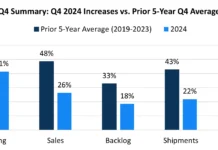by Chris Kuehl, managing director
Armada Corporate Intelligence

Thus it begins – at least formally. What kind of economic growth does the Trump administration seek? What kind of shape is the economy as he takes over – as compared to what other presidents before him faced? What are the chances his goals will be met, and what are the factors that will make accomplishing these goals tough and perhaps even impossible? In the most general terms, he inherits an economy that has clearly started to recover from the grinding recession that began in 2008 and is in far better shape than when Obama took control. It is not as good as the economies of either Reagan or Clinton.
As the term starts, Trump will be facing at least three trends that were initiated in 2016 and are expected to be a major factor in the coming year. The expectation for interest rates for most of the last eight years has been that they would stay low. This is a policy that doesn’t have all that much to do with the President and has developed over the course of two Federal Reserve chair terms (Bernanke and Yellen). Interest rates rose in December, and the current assessment holds that they will go up at least twice more in the coming year to end up somewhere between 1 percent and 1.5 percent.
The second development is inflation – mostly driven by higher wages in select sectors. The rate now is close to 2 percent at the core level and is expected to continue inching up. Nobody is expecting hyperinflation or anything even close. For now, this level actually will be a good thing and stimulative to a degree. It also will help convince the Fed that rate hikes remain a good idea.
The third development is the strong dollar, and that could be the most vexing of the three. Much has been made of the desire to promote exports and reduce imports, but a strong dollar will make that all the more difficult to obtain. Trump broke with decades of tradition by calling for the dollar to be weakened but was immediately contradicted by his treasury secretary, who reiterated the US commitment to a strong dollar. Beyond the verbiage, it is hard to shift the power of the currency, as this depends largely on the actions of the Fed and the overall global demand.
As he develops policies that match the claims and aims of the campaign, Trump is in better shape than some of his predecessors and is facing bigger problems than others. Labor force participation is lower than it has been since Gerald Ford was in office. It now is just a little above 62 percent and, at the start of the Obama term, it was at just over 66 percent. At the start of the term for George W. Bush, it was over 67 percent and the two presidents before Bush (Clinton and George H.W. Bush) presided over an increase in the rate. This is a complex measure of the workforce, as there are many reasons a person may be out of the workforce. The number one factor is retirement, and there have been more people ending their work careers than ever – at least 10,000 a day as the Boomers age in their golden years. Regardless of why people are leaving, there is an issue with having too few people to fill the jobs that are becoming available as too many of those seeking jobs lack the skills that are in demand.
One of the more challenging tests will involve manufacturing, as this was a big part of the campaign and has been a concern for years. The US has been regaining its status as a manufacturing state for years and never stopped being a dominant player. These gains have largely come at the expense of jobs, as robotics and technology have replaced a lot of the people who once worked in these factories and manufacturing facilities. The number of people directly employed in manufacturing has been declining since Eisenhower was in office. It was close to 35 percent when his term started and was down to a little over 30 percent when it ended. Every president since then has presided over a further reduction of the manufacturing workforce, and Trump starts with the lowest level yet – around 8 percent of the total US workforce. Remember that these are workers who are directly engaged in manufacturing – if you count all those people who work for manufacturing companies, the percentage employed is closer to 30 percent. To increase the number of people working in manufacturing will be a nearly impossible task, given the preference for the implementation of technology. Banning imports and restricting where US companies produce will have a minor impact and could even make the problem worse, given that most manufacturing jobs are in small and mid-sized companies.
Manufacturing in the US seems to be plagued by misnomer and myth, and this has been the case for years. Perhaps it is because so few people ever actually see inside a manufacturing facility. For years, the story was that there was no longer a manufacturing sector in the US, although the numbers never bore this out. It has been about 30 percent of the GDP when one looks at all the people employed by the manufacturers – not just the ones who are running the machines.
Today, the political emphasis is on manufacturing jobs, and there are myths here as well. The political assumption is that companies are ditching US workers to set up in foreign countries. Although this does still happen, the biggest issue is replacing human workers with machines – and import restrictions will have no impact on this. There is, perhaps, good intent behind the moves that Trump plans to make, but there is a good chance for a backfire if there is failure to understand the real issues in manufacturing. A steel import tax will be good for the steel industry, but not so good for the users of that imported steel the manufacturers that Trump wants to see hire more people.
Chris Kuehl is managing director of Armada Corporate Intelligence. Founded by Keith Prather and Chris Kuehl in January 2001, Armada began as a competitive intelligence firm, grounded in the discipline of gathering, analyzing and disseminating intelligence. Today, Armada executives function as trusted strategic advisers to business executives, merging fundamental roots in corporate intelligence gathering, economic forecasting and strategy development. Armada focuses on the market forces bearing down on organizations. For more information, visit www.armada-intel.com.




